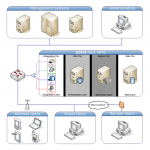Kurt Stump’s S3CO Root WMS Technology / Enterprise Architecture
S3CO Root WMS Technology / Enterprise Architecture
S3CO Root WMS was designed and written with five basic architectural principles:
- Integrate easily with any existing business system using open standards
- Allow for scalability
- Centralize administration
- Eliminate the need for client upgrades
- Develop in Java and JDBC for open system connectivity, extensibility, portability, and lower TCO (total cost of ownership)
Enterprise Architecture
S3CO Root WMS Logical Enterprise Architecture:
Root WMS was designed to conform with the latest enterprise architectures. Root WMS is an n-tier application supporting open web application standards, service-oriented architectures (SOA), open database connectivity, and open analytics. Root WMS’s server-centric design facilitates the most flexible, yet simplified implementation available.
Root WMS is a J2EE Java web application written with JavaServer Faces (JSF), so Root WMS can conform to your environment. Root WMS performs equally well on Microsoft Windows, Linux, Solaris, or any other Java-enabled platform — allowing you to maximize the benefit of your existing hardware investments. Additionally, since Root WMS is written in Java and supports JDBC open database connectivity, it will also leverage your existing database infrastructure.
The four S3CO Root WMS tiers are independent, logical processes, yet all four can run on the same server. Running on a single machine is acceptible for most installations, but when additional scale is required any combination of the various tiers can run on multiple machines.
Integration Tier (Integration Layer)
The S3CO Root WMS Integration Tier logically connects existing business systems with Root WMS. Flat file import data (XML and .CSV) is processed via Java and JDBC. Web Services (XML SOAP) are processed via a Java Servlet and JDBC. Direct database connectivity is handled as a process within an existing ETL package, the originating data sources, or the S3CO Root WMS database.
The S3CO Root WMS Web Tier connects clients, administrators, and managers to Root WMS through HTML over HTTP. Written in JavaServer Faces (JSF), Root WMS requires a web container like Tomcat, JBoss, WebSphere, Sun Java Application Server, etc. Secure connections are available via HTTPS, but HTTP is suggested for maximum performance.
System Tier (Application Layer)
The S3CO Root WMS System Tier is the core of Root WMS. Material Allocation, Picking, Cycle Counting, Cross-Docking, system monitoring, etc. happen here. Core WMS processes are written in Java with JDBC connectivity. API stub classes for client modification are clearly documented.
The S3CO Root WMS Data Tier is the database component of Root WMS. Root WMS’s open connectivity is provided by Java JDBC. Additional database connectivity is available by any means supported by your DBMS vendor.
Root WMS provides data import and export tools. Additionally, since all transactions are logged simultaneously to database and flat files, in the event of a database failure S3CO’s schema creation scripts and a copy of the transaction can recreate the system database and have you back online in a matter of minutes. — Kurt Stump, Enterprise Architect
Infrastructure
S3CO Root WMS is a J2EE web application with independent system, integration, and database functionality. All system components can run on dedicated servers for scale and fault-tolerance or they can just as easily run on the same server for simplicity and cost-effectiveness.
Since Root WMS is a web application, it does not require robust, end-user processing machinery. Users can interact with the system on any browser-enabled hardware, instead of high-powered systems with multiple configurations and system requirements.
Integration Architecture / Data Feeds
Root WMS supports standardized enterprise integration strategies. Root WMS supports XML SOAP web services, ETL (extract, transform, and load), and a user-configurable .CSV (comma-delimited) interface protocol for easy data communication between S3CO Root WMS and your existing management systems.
Database Architecture
Root WMS implements Java JDBC open database connectivity, so Root WMS can support any JDBC-enabled database management system (DBMS). Initial Root WMS development was done on the open source DBMSs PostgreSQL and MySQL, but future versions will support Oracle, Microsoft SQL Server, and DB2.
Automation / Barcode Scanning / Wireless Printing / Material Handling
- Root WMS supports any browser-enabled platform including desktop PCs, iOS Devices (iPad, iPod, iPhone, iCloud), Android Devices, Pocket PCs, Palm PCs, Linux / UNIX, Macintosh, etc.
- Root WMS supports any barcode scanning technology capable of populating browser text.
- Root WMS utilizes network enabled barcode printer using LPD/LPR, IPP, FTP, TFTP, Telnet, HTTP, or S3CO’s proprietary printing mechanism.
- S3CO Root WMS facilitates the use of any material handling equipment.
Total Cost of Ownership
S3CO Root WMS’s support of open source software (both the management server and database) and the reduced hardware requirements that come with their use force the total cost of ownership curve down. Now your investment will be in the components that generate the value add (handheld terminals, printers, wireless networking, and WMS software) instead of proprietary server and database client licenses.


No Comments Comments Feed
Sorry, the comment form is closed at this time.
The comments are closed.